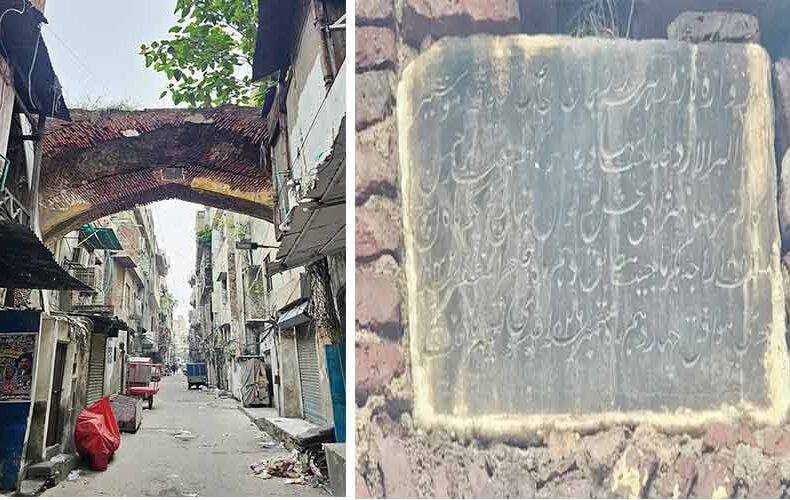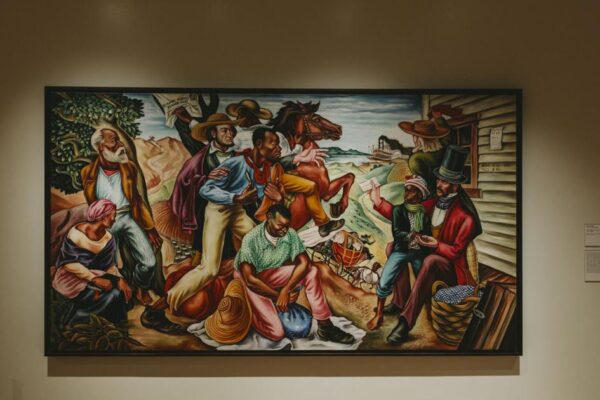
The crumbling gate of Anarkali Bazaar
**The Hidden Heritage of Anarkali: Uncovering the Historic Gate Behind Yousuf Falooda**
In Old Anarkali Bazaar stands a shop named Yousuf Falooda. Just behind it, in the narrow gali (street), an old brick arch survives, topped with a Persian plaque. At first glance, this arch seemed to date from the British era. However, the small bricks, coarse mortar, and Persian inscription told a different story, adding distinctive historical value to this relic.
The Persian plaque reads:
*“Gate of Harsa Raziman Bazaar, located in the region of Moshir, was built under the supervision of Mir Abdul Rahman, with the assistance of Elahi Bakhsh Kotwal, by the order of Allard Sahib Bahadur on the 1st of the month of Asuj, 1883 Raja Bakrmajit, according to the 10th of the month of Safar 1242 Hijri, equal to September 14, 1826.”*
This gate, inscribed with dates in the Samvat, Hijri, and Julian calendars, is a rare discovery. It stands as a testament to a bygone era, dating back nearly 200 years.
According to the plaque, in 1826 AD, the area was known as Bazaar Raziman. Today, it is called Risala Bazaar, with “risala” meaning cavalry in Arabic.
Listed on the plaque as overseeing the gate’s repairs is Elahi Baksh Kotwal, a renowned Muslim officer who served in the Khalsa Fauj for more than 40 years. He was considered one of the finest artillery officers during Maharaja Ranjit Singh’s reign. The repairs were carried out on the orders of Gen Jean-Baptiste Allard, commander of the Khalsa cavalry forces.
Historical records indicate that this area was the infantry hub of the Sikh army, commanded by Gen Jean-Baptiste Ventura. This has led historians to suspect that the archway may have once formed the gateway to the Anarkali Infantry Cantonment, established by Maharaja Ranjit Singh in the early 19th century and demolished by British occupation forces in Lahore in 1847.
—
### Tracing History Through Maps
To better understand this heritage, researchers studied old maps of Lahore from the British and Sikh periods.
Using Google Maps, the site was first geo-located, then traced on an April 1868 map of Lahore published during British rule. This map shows that the Sikh-era barracks had already been demolished by then, with the British redeveloping the site.
The *Umdat ut Tawarikh*, Persian court chronicles, record British orders in 1847 to demolish the Anarkali cantonment.
For further investigation, the researchers found a March 1846 map of Lahore prepared by A. Frazer, titled *Lahore and its Vicinity* (scale: four inches to one mile). This map identified Sikh-era havelis, gardens, and generals’ camps, offering rich insight into 19th-century Lahore.
Upon geo-locating the arch on the 1846 map, it was discovered to stand within the South Infantry Barracks of the Anarkali Cantonment, at its eastern entrance. These barracks were under Gen Ventura’s command, whose residence lies just east. Directly south were the Cavalry Lines commanded by Gen Jean-Baptiste Allard.
The ruins of Allard’s old cavalry lines still appeared southwest of the South Infantry Barracks, while opposite the barracks was his garden — the burial place of his daughter.
—
### Rediscovering a Lost Gateway
It was ultimately confirmed that the 1826 arch was part of the Sikh-era Anarkali Infantry complex. Yet, something about the structure seemed incomplete.
In July 2025, the co-authors visited the site behind Yousuf Falooda. The arch, which had stood for more than two centuries, was found crumbling, brick by brick.
A striking detail emerged during this visit: remains of columns on both sides of the street about 15 feet from the arch. The arch that once spanned these columns had disappeared.
This suggests that what remains today is not just a simple arch but part of a much larger gate — roughly 15 to 20 feet long — marking the eastern entrance to the Anarkali South Infantry Barracks.
Comparing the 1846 and 1868 maps shows that the British kept the original road alignment from Lohari Gate to the Anarkali Cantonment, even while redeveloping the surrounding area and retaining much of the old Anarkali layout.
—
### The Urgent Need for Preservation
Today, this historic gate, a significant part of Lahore’s heritage, is in urgent need of preservation.
Without prompt intervention, it risks crumbling beyond repair.
The Walled City of Lahore Authority must act swiftly to restore and safeguard this site. Furthermore, a historical marker should be installed to commemorate both the gate’s past and the efforts made to preserve it.
—
### A Call for Systematic Documentation
The discovery of this gate raises an important question: how many more undocumented historic sites still stand hidden in the Anarkali Bazaar area?
A systematic survey is essential if Lahore’s rich history is to be preserved.
This documentation should be a collective responsibility involving history interns, volunteers from heritage societies, universities, government agencies, and private organizations.
Only through such collaboration can the city’s historic fabric be truly safeguarded.
—
**To build a promising future, we must first preserve our past.**
*Dr. Adnan Tariq*
Assistant Professor, Government College University, Lahore
https://www.thenews.com.pk/tns/detail/1345052-the-crumbling-gate-of-anarkali-bazaar
You may also like


To Avert Crisis, Talladega College Sells Its Art Treasures

Buñuel was here
推荐阅读
You may be interested
The incredible transformation of Elastigirl on screen
**The Incredible Transformation of Elastigirl on Screen** *By Vinita Jain...
Golden Age Thursday: T.S.O.L. Run Through Early Material During Hectic 1981 Performance In California
T. S. O. L., like any memorable punk band, has...
‘I respect all religions’: CJI after idol remarks spark row
By Chanshimla Varah | Sep 18, 2025, 04:22 PM **Chief...
 The New York Times
The New York Times
- California Gets Heavy Rain, Snarled Travel and Power Outages for Christmas 2025 年 12 月 25 日 Alexander Nazaryan and Thomas Gibbons-Neff
- $1.817 Billion Powerball Jackpot Won by Single Ticket in Arkansas 2025 年 12 月 25 日 Dan Watson and Rylee Kirk
- Christmas Around the World in Photos 2025 年 12 月 25 日 The New York Times
- Why Russia Is Likely to Reject the New US-Ukrainian Peace Plan 2025 年 12 月 25 日 Ivan Nechepurenko
- No Power, No Heat, No Water: Odesa’s Days of Hell Under Russian Fire 2025 年 12 月 25 日 Kim Barker, Oleksandra Mykolyshyn and Laetitia Vançon
- Prominent Leaders Amplify Disinformation About Brown University Shooting 2025 年 12 月 25 日 Steven Lee Myers
- With Airspace Closed, a Lonely Christmas for Many Venezuelans 2025 年 12 月 25 日 Annie Correal
- Estonia’s Man on Capitol Hill Is on a Charm Offensive 2025 年 12 月 25 日 Adam Sella
- Pope Leo Makes Christmas Call for Dialogue to Address World’s Conflicts 2025 年 12 月 25 日 Motoko Rich
- King Charles Urges ‘Compassion’ and Finding Strength in Diversity in Annual Christmas Message 2025 年 12 月 25 日 Lizzie Dearden
Leave a Reply